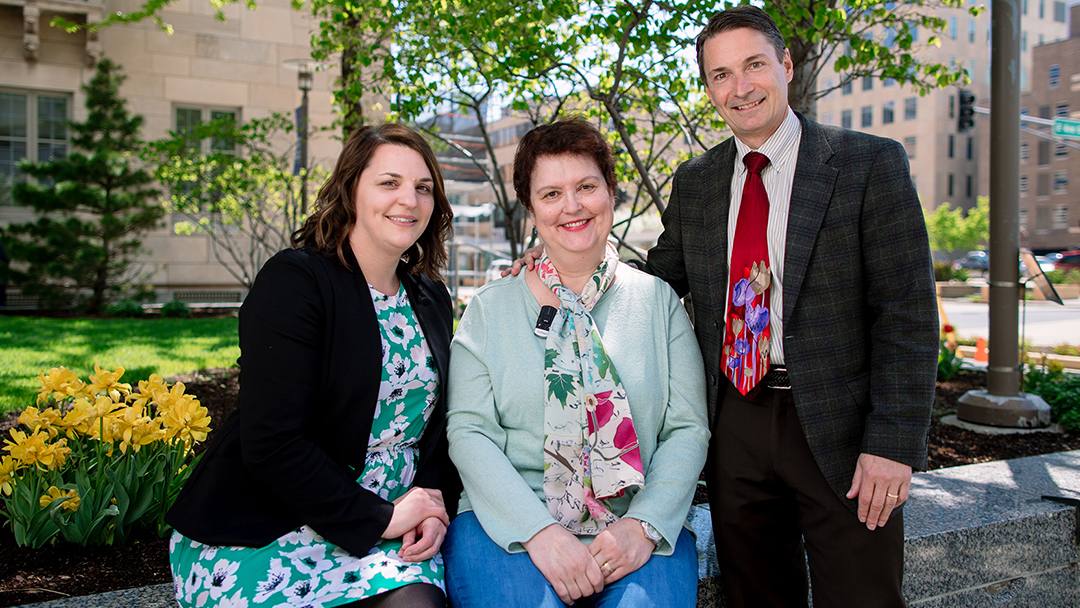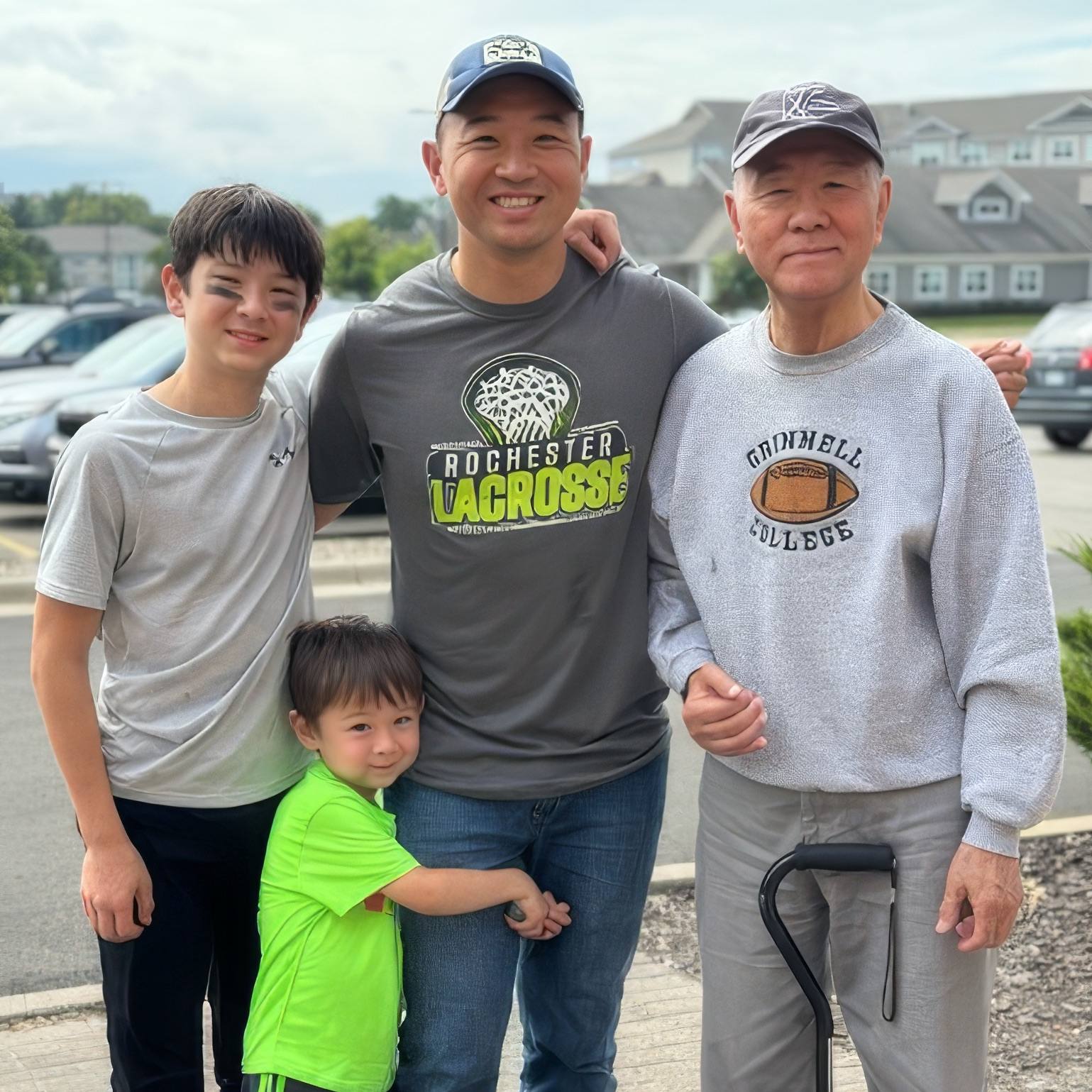-
A Noise-Filled Hearing Loss Journey

Suffering from severe hearing loss and struggling to find answers, Dianne Lee Needham turned to Mayo Clinic's Cochlear Implant Program. Here she shares in her own words how the care she received has dramatically improved her quality of life.
Written by Dianne Lee Needham
Three years ago, my hearing was fine until I flew from New York City back home with a bad head cold. Once home, the cold worsened and required a family doctor visit, antibiotics and then an ENT [ear, nose and throat] appointment not far from where I reside in Arizona.
"Let's get you some hearing aids, honey," said the ENT doctor (the first of many I went to for help) as he ushered me toward his audiologist's door. The audiologist, wearing a panda print design scrub top, gestured toward the sound booth. Taking a seat on the toddler-size chair, I saw them: the milk-drinking bunny, the cymbal-clapping monkey and the drum-playing frog with their gazes fixed on me. Smiling, the audiologist asked if she could wind up the mechanical toys for me. I had no response. I did not get hearing aids at that time.
A few days prior to seeing that first ENT physician, I had recovered from the upper respiratory event but noticed an awful fullness on both sides of my head. I was not aware of what was happening, but my hearing function was failing, and the horrible noise in my head would never leave.
No physician seemed to know what to do with me. For 12 weeks from the onset of my cold, I couldn't sleep, eat or function normally. I had suicidal thoughts.
Searching for answers
I bounced from my internal medicine physician practice to one ENT doctor after another, one neurotologist to another, and finally to an independent audiologist. The doctors' diagnoses seemed uncertain and recommended treatments varied greatly. They all agreed I had progressive bilateral sensorineural sudden hearing loss with extreme tinnitus. They eventually deemed a cochlea virus stemming from my head cold as the likely culprit.
An MRI showed no tumors or issues with my internal auditory canals. Blood work was completely normal, and I had no prior history of hearing function problems or contributing disease factors. I was basically very healthy.
Name it, I tried it, for both my hearing loss and my tinnitus: intratympanic steroid injections, low-salt diets, sound therapy, meditation, vitamin supplements, focused activities, custom harmonics software and earbuds, and more.
Leading with self-advocacy
Finally, an independent audiologist fitted me for hearing aids. For a while, I had improved hearing and a fair amount of relief from tinnitus when I used the sound generator feature on my hearing aids.
After a year or so, however, I noticed I couldn't hear well at all, especially on the left side with the right a very close second. Tinnitus was, and is, in both ears — a freight train roar wrapped by fluorescent light bulb buzzing on the left and crickets blended with Morse code on the right. It is hearing loss coupled with 24/7 noise nonstop. Day and night. Intolerable. I longed for silence. I longed to be able to hear better and to understand anyone who spoke to me.
"My tinnitus was rated as catastrophic — always heard, disturbs sleeping and makes all activities difficult." — Dianne Lee Needham
At this point, I decided to lead, not follow, in the pursuit of help. I had to. My self-advocacy led me to the Mayo Clinic Cochlear Implant Program. Mayo's dedicated multidisciplinary cochlear implant team approaches each case individually. They consider all aspects and parts of a patient's otolaryngological medical circumstances. Their goal is to bring improved hearing and, when possible, tinnitus relief.
Qualifying for an implant
My first appointment at Mayo Clinic as a potential cochlear implant candidate was for specialized hearing tests conducted by Amy Olund, Au.D., a cochlear implant audiologist. Severe hearing loss was displayed on my left side and moderate to severe hearing loss on my right. My tinnitus was rated as catastrophic — always heard, disturbs sleeping and makes all activities difficult.
I then consulted with Colin Driscoll, M. D., in Otorhinolaryngology. He greeted me, asking how I was doing. "Anxious," I replied.
"Dianne, we make it very difficult to pass the audiology exams for an implant, and you failed at every critical juncture," he said. "It is highly likely you will hear better with an implant than you do with your hearing aid."
Having already reviewed my related medical history and MRIs, he indicated I qualified to receive a cochlear implant. Both Drs. Driscoll and Olund agreed that the combination of my severe progressive hearing loss and disruptive tinnitus made me a good implant candidate.
Hearing restoration
A cochlear implant goes past the damaged parts of the inner ear, directly stimulating the auditory nerve. The surgically implanted medical device can improve hearing in individuals with severe or profound hearing losses. It produces an array of sounds; however, normal hearing is not replaced.
When the brain is not receiving sound information, it creates phantom noises or tinnitus. A cochlear implant transmits sound information to the cochlea nerve cells. The implant is not a cure for tinnitus. But when the device is activated, it can suppress the brain noises.
"Bilateral asymmetric sudden sensorineural hearing loss with associated severe tinnitus can be a challenge. We see a lot of unilateral cases, but bilateral loss is observed less often in adults," Dr. Driscoll says.
"What happened to Dianne physiologically is speculation. Was there really a virus in the inner ear? Who knows. Is it autoimmune or other inflammatory process? Unknown," Dr. Driscoll adds. "There is no way to look at the pathology of the ear or test the actual tissue or fluid. Nobody lets us take their ears out at the time to study them."
Making clear progress
I received my cochlear implant a month after meeting the Mayo team. The diligent, practiced care and eloquent surgical techniques of Dr. Driscoll and his resident team (in my opinion the best in the country) completed the outpatient procedure in approximately an hour and a half. Postoperatively there is no pain to speak of, and minimal blood loss and scarring. I found it daunting and amazing.
A few weeks after the surgery, my device was activated by Dr. Olund. I could hear in my ear and the tinnitus noise intensity dropped immediately. The initial ambient sounds that come through the device are mechanical, and human voices have a Darth Vader-like quality. But only weeks after implantation, I clearly heard my car turn signal clicking, the toilet flushing and the coffee maker percolating. And most importantly, my husband Howard's voice saying, "I love you."
"At Mayo, for the first time in my hearing loss journey, I felt like the medical specialists cared enough to truly listen to me." — Dianne Lee Needham
I will return to Mayo for a year's worth of aural rehabilitation to retrain my brain how to hear.
Because I wear an implant on my left hearing side and a hearing aid on my right side, I am bimodal — wearing electric and acoustic assistive hearing devices.
"Bimodal listening is challenging because users are required to learn two different pieces of technology. The cochlear implant and hearing aid have different features and controls and are often adjusted independently," Dr. Olund says. "On a positive note, these technologies have begun to merge, making it easier for bimodal listeners."
 Hearing and listening
Hearing and listening
Mayo cochlear implant team members and my loving husband, Howard, have saved my life and given me an improved quality of life — with better hearing and the defeat of tinnitus. Now I hope my Chicago Cubs return to the World Series, so I can really hear the game (not like when we attended Game 4 of the 2016 World Series, Chicago Cubs versus Cleveland Indians).
At Mayo, for the first time in my hearing loss journey, I felt like the medical specialists cared enough to truly listen to me. I once read that "hearing is involuntary; listening is a choice." The Mayo otorhinolaryngology specialists exemplify this statement in all ways. They are accessible, patient, kind, medically astute, and willing to teach and educate you.
And both Dr. Driscoll and Dr. Olund tell me it will "only get better from here."
HELPFUL LINKS
- Learn more about cochlear implants.
- Read about the Department of Otorhinolaryngology.
- Explore Mayo Clinic.
- Request an appointment.







